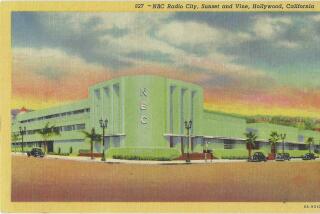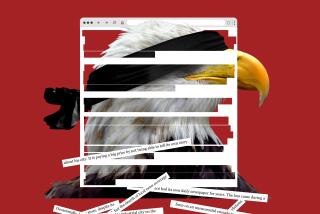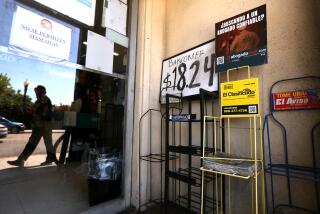S.D. TV News--It All Started With a Phone Call : Media: Ted Leitner and Michael Tuck set the course in the decade’s ratings wars, while radio played musical call letters.
- Share via
SAN DIEGO — The phone call that would shape the course of San Diego television news in the ‘80s was made July 15, 1978.
During a decade when TV news personalities rolled through town like tumbleweeds in a tornado, nothing had the impact of that call, made by Ted Leitner to Michael Tuck, an old buddy from his days with WCAU-TV in Philadelphia.
There, sportscaster Leitner was, to put it lightly, despised. And when you’re despised in Philadelphia, they let you know it. He was fired from WCAU.
When he arrived in San Diego to be the new sportscaster at KFMB-TV (Channel 8), the opinionated Leitner wasn’t exactly loved. When he was introduced to the crowd at a San Diego Clippers basketball game shortly after he started, he was loudly booed.
But San Diego is different than Philadelphia. Not only was Leitner improving his tan, he found San Diego fans to be far less brutal in their reactions. In addition, his new young boss, Jim Holtzman, was full of ideas and looking to build a new team.
Come to San Diego, Leitner told Tuck.
After Tuck did in October, 1978, San Diego television was never the same. By the December, 1979, ratings book, Channel 8 had moved into first
place, starting a chain of events that changed the shape of San Diego television news in the decade ahead.
In radio, some of the names changed and some of the formats changed in the ‘80s.
Former San Diego Mayor Roger Hedgecock became a talk-show star for KSDO-AM (1130) after being convicted of a felony. Various rock ‘n’ roll formats popped up across the dial, but none could seriously damage the superiority of KGB-FM (101.5), although XTRA-FM (91X) was able to carve out a niche with its “cutting edge” format.
And, spurred by the success of KFMB-FM’s (B100) “Morning Zoo,” half a dozen wild and wacky morning teams came and went.
But nothing in radio resembled the impact made in television news by the team assembled by Channel 8’s Holtzman.
Whether they liked him or hated him, San Diegans tuned in in droves to watch and listen to Leitner. Along with Tuck, he was the catalyst that vaulted the Channel 8 news team into a four-year run as the undisputed king of the San Diego news ratings race. With his buddy Tuck paired with the light and pretty Allison Ross, it was the seminal team of the decade.
Success allowed Holtzman to experiment. In 1986, he tried the most progressive newscast ever attempted in San Diego. Called “This Day,” it was a slick new approach to the 11 p.m. news, attempting to find a common thread to run through the newscast, with understated graphics and a multi-personality approach.
For Holtzman and Channel 8, “This Day” was a ratings disaster. A few months later, it was off the air and Channel 8 was back to a more traditional approach.
But other experiments by Holtzman were more successful. Certainly it was risky to put witty, sometimes abrasive, comedian Larry Himmel on the air to do regular commentaries. But, like Leitner, Himmel created a sensation.
Eventually, in 1985, Holtzman was able to convince the station to give Himmel his own show. Airing each weeknight at 7, “San Diego at Large” was a mixture of homey features, wacky sketches, soap opera parodies and quirky, time-killing features.
With a raw, homemade feel, it was undoubtedly unique in San Diego television history. It lasted more than three years, finally succumbing to mediocre ratings. There may never be anything like it on the air here again, and Channel 39’s attempt last year to re-create the magic with a new Himmel show formatted like a traditional variety show failed miserably.
The success of the early Channel 8 news team propelled Tuck to his own stardom, which eventually led him to jump ship to KGTV (Channel 10) in 1984. There, in addition to his stoic anchoring stints, Tuck became the avenging angel of the San Diego airwaves, doing nightly commentaries with evangelical fervor, railing against the San Diego establishment.
Tuck’s own rising star at Channel 10 rivaled that of Leitner’s and helped make Channel 10 competitive with Channel 8. Eventually, with Bree Walker teaming with Tuck, it surpassed Channel 8.
Walker left and was replaced by Kimberly Hunt, but that made no difference in the ratings’ strength of Channel 10 in the latter half of the ‘80s. Anchorwoman Carol LeBeau became a familiar face to viewers, and the days of abrasive anchorman Harold Greene seemed long removed for the light and fluffy--and successful--Channel 10 team.
At Channel 39, which started the decade as KCST and ended it as KNSD, it was a decade of frustration. The new call letters and a new station indentity campaign instituted in 1988 by new owners Gillett Communications did little to reverse the station’s fortunes.
Throughout the decade, even as increased cable penetration mitigated the problems that people had receiving Channel 39’s UHF signal, the perennial third-place finisher in the ratings race was never able to consistently break out of its pattern. Attempts at a 6:30 p.m. newscast by the station were successful only until the other stations started a newscast in the same time slot.
After stints at Channels 8 and 10, sandwiched around a gig in Washington, Marty Levin arrived at Channel 39 in 1987. Channel 39 also inherited ex-Channel 10 anchorwoman Susan Farrell and Channel 8’s elder statesman, Bob Dale, who came on board late in the decade to do weather. But none of the new personnel, though familiar to San Diego viewers, seemed to help.
Channel 39 also inherited ex-Channel 8 reporter Gene Cubbison, who left the more successful station after the infamous Mac Heald incident. In 1982, Heald, a reporter and weekend anchor, was charged with child molestation. Cubbison left after the station initially kept Heald at the station, albeit off the air, until he was convicted.
Heald was just one of many characters that came through San Diego TV news departments in the ‘80s. Most, like Dennis Morgino, Walker, Loren Nancarrow and others, went on to bigger and better markets. Others, like former Channel 39 anchorwoman Laura Buxton, who reappeared in 1988 as co-host of Channel 10’s talk show “Inside San Diego,” simply switched their dial allegiance.
Such was the course of television news in San Diego. The names changed and the faces changed, but little of substance changed. In a decade that was supposed to herald a new era of communications, there were few substantial changes in the way television news was presented, except perhaps, for an increased awareness of the Hispanic audience, which led channels 8 and 39 to simulcast their news programs on Spanish radio.
The status quo also held true in radio, which became more and more predictable as marketing experts helped stations better target specific audiences.
Most successful of the ‘80s stations was KKLQ (Q106), which carved out a huge audience with its teen-oriented Top 40 sound. KKLQ occupies the dial position that was previously home to KLZZ’s easy-listening format and the rock ‘n’ roll of KPRI.
The number of radio formats and call letters that changed in the past 10 years are too numerous to name, as stations looked for the right mix for the right time. KOGO-AM’s (600) news format, the adult contemporary hits of KBZT (K-Best) and the elevator jazz of KSWV-FM (102.9) were just a few of the casualties of the ‘80s.
Those that endured seemed stronger than ever. KFMB-AM (760) and its morning team of Hudson and Bauer persevered, as did KFMB-FM’s (B100) “Rich Brothers’ B-Morning Zoo,” even though its namesake, Bobby Rich, left for a job in Seattle last year. KSDO also withstood all challenges to its news-talk audience, most recently XTRA-AM (690), which dropped a moderately successful oldies format to challenge KSDO.
In the country music wars, KSON-FM (97.3) reigned supreme, beating out KCBQ-FM, (105.3), which eventually switched to an oldies format.
KIFM (98.1) went through a period with interim owners, after the FCC revoked the station’s operating license, but in April the former general manager, Bruce Walton, returned to guide the station’s jazz format.
Walton even brought back Art Good for a third stint at the station. Good, the local “Godfather” of the airy modern jazz sound, left the station twice before for work at K-Best and KSWV.
And perhaps that feature most typifies the ‘80s in TV and radio in San Diego: The more things changed, the more they seemed to stay the same.
More to Read
The complete guide to home viewing
Get Screen Gab for everything about the TV shows and streaming movies everyone’s talking about.
You may occasionally receive promotional content from the Los Angeles Times.






